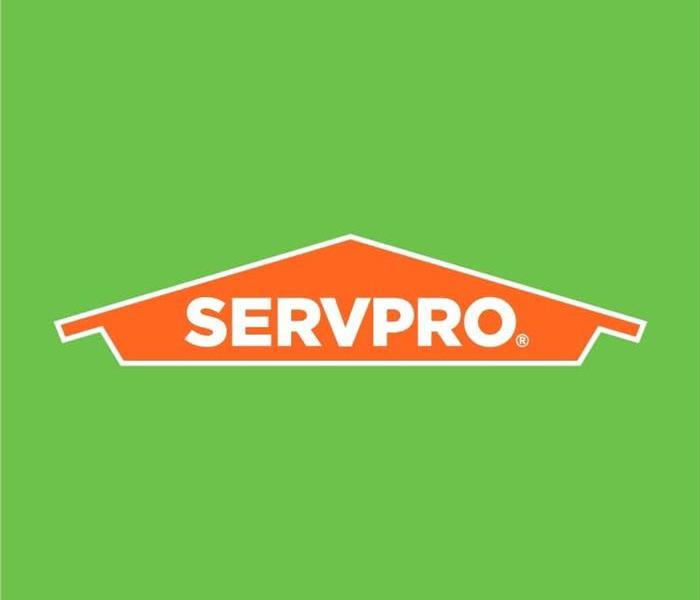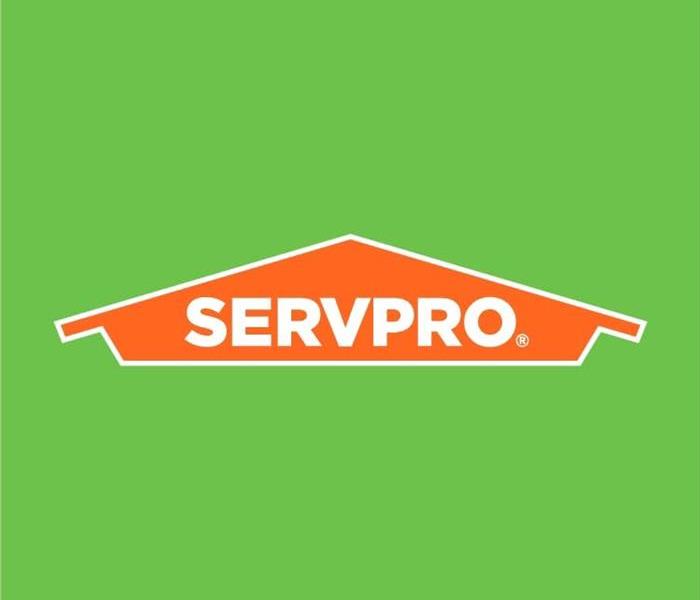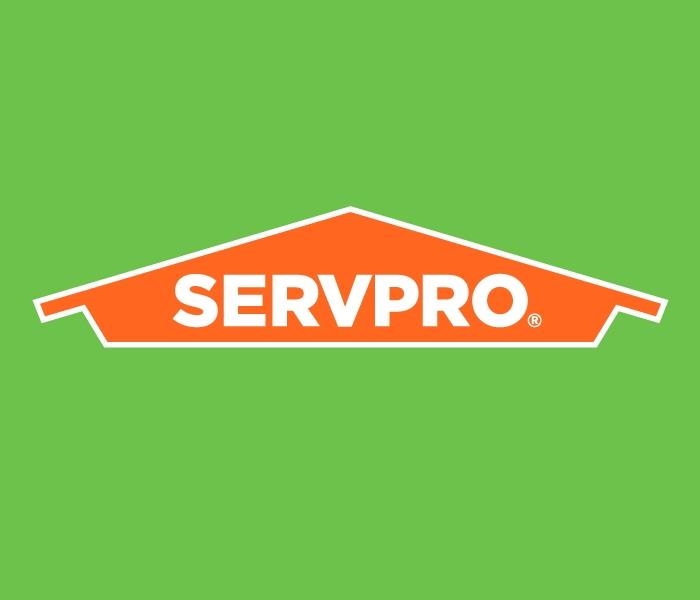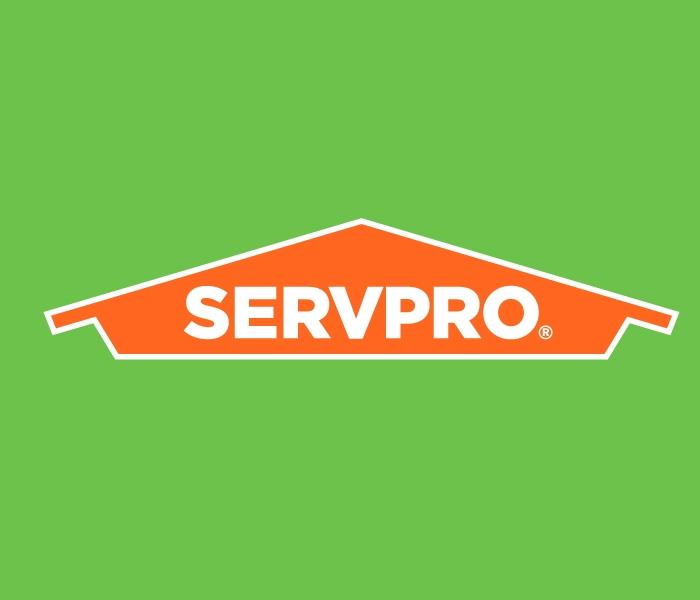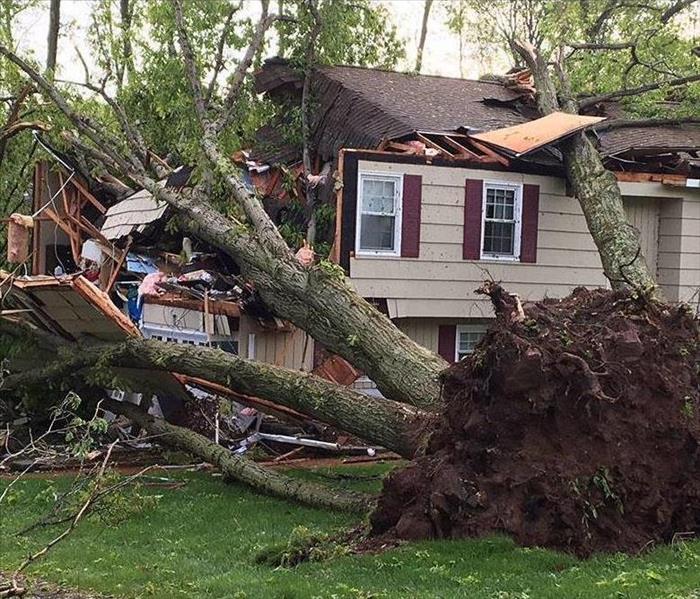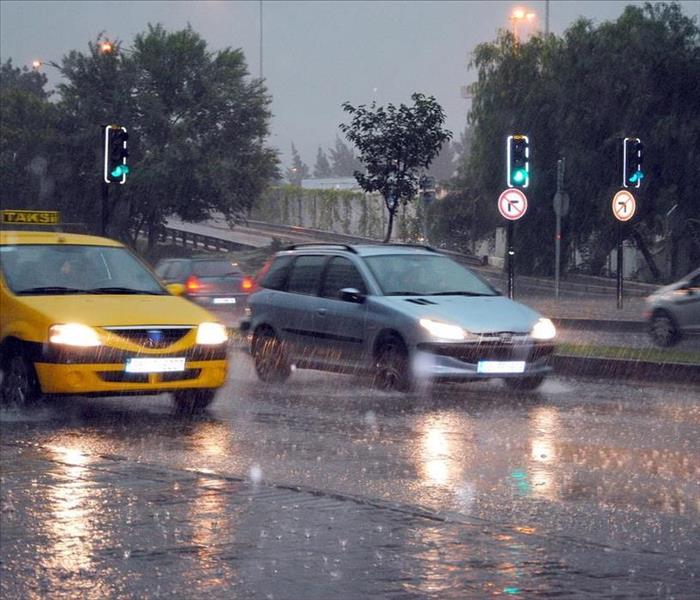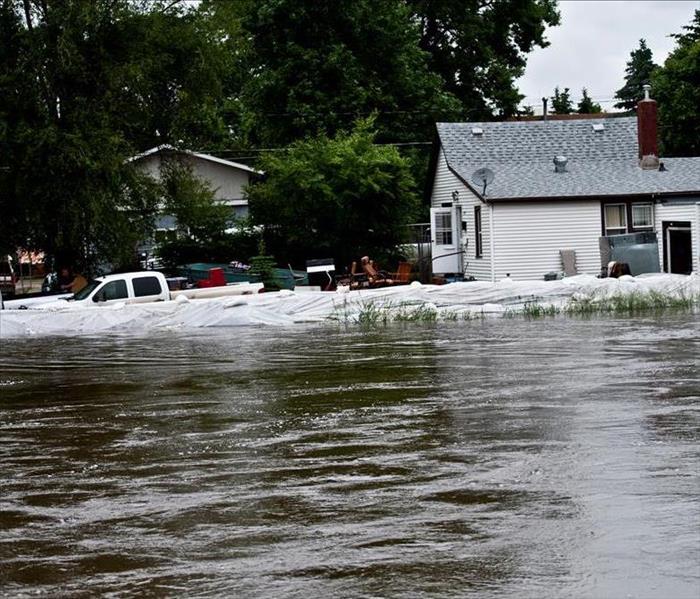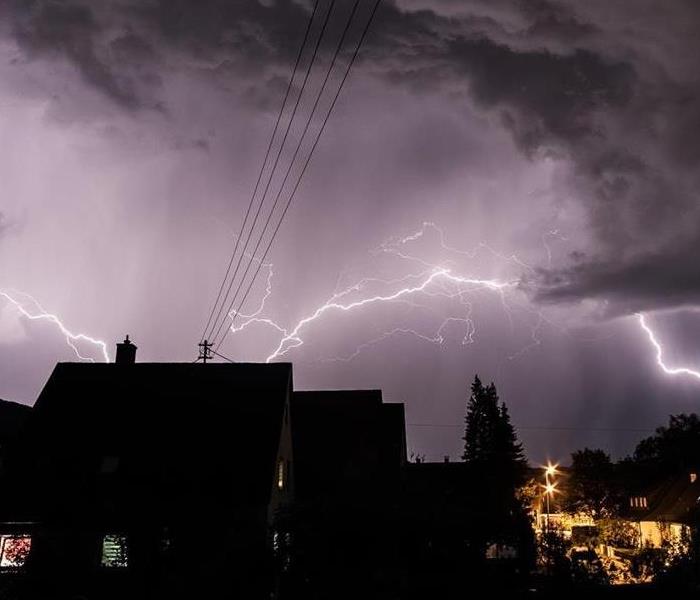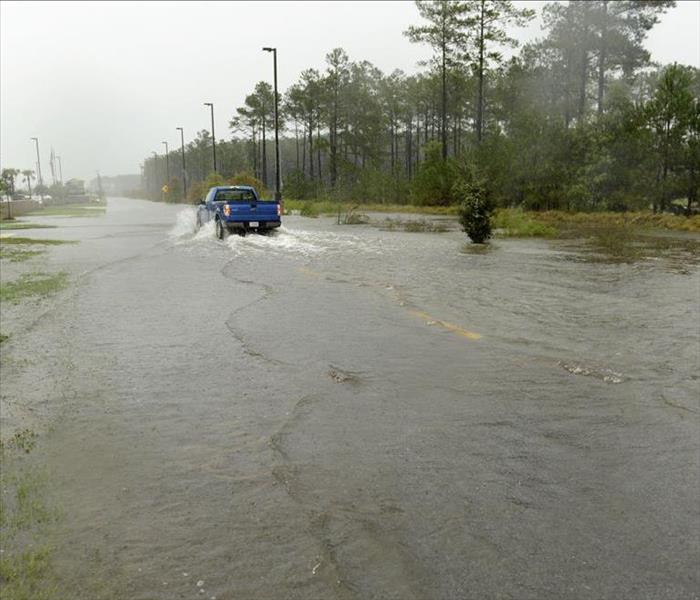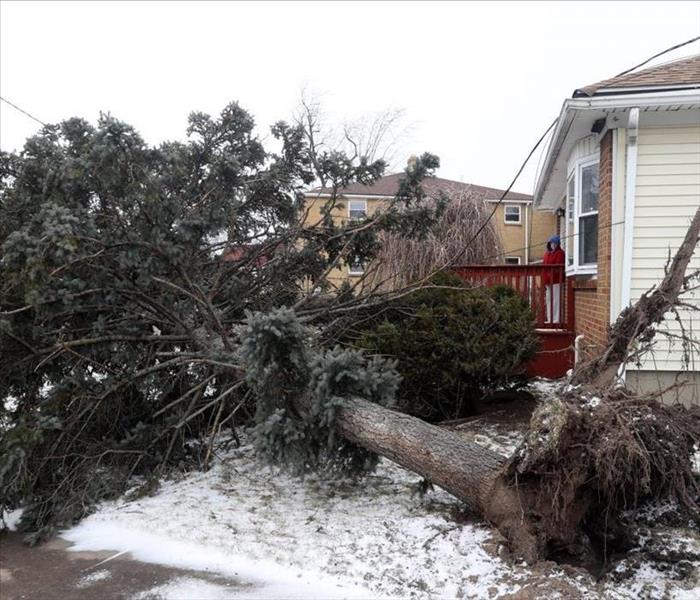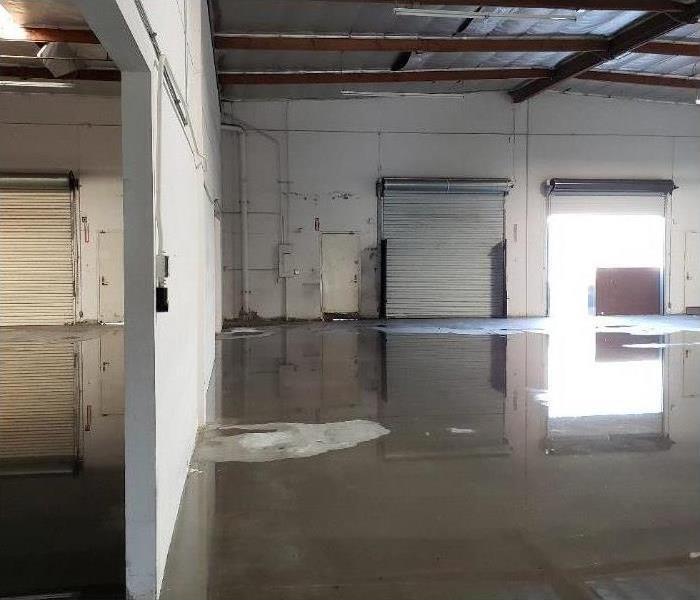Archived Storm Damage Blog Posts
Storm Damage Restoration: How SERVPRO® Helps You Recover
12/17/2024 (Permalink)
Storms can wreak havoc on homes and businesses, leaving behind a trail of destruction that requires immediate attention. SERVPRO specializes in storm damage restoration, offering comprehensive services to help you recover swiftly and efficiently.
Why Choose SERVPRO for Storm Damage Restoration?
•Rapid Response: Time is crucial when dealing with storm damage. SERVPRO is available 24/7 to respond promptly to your emergency, minimizing further damage and reducing restoration costs.
•Comprehensive Services: From water extraction and structural drying to debris removal and mold remediation, SERVPRO provides a full spectrum of restoration services tailored to your specific needs.
•Expertise and Equipment: Our highly trained professionals utilize advanced equipment and techniques to restore your property to its pre-storm condition, ensuring a thorough and efficient recovery process.
Our Storm Damage Restoration Process
1.Assessment: We conduct a detailed inspection to evaluate the extent of the damage and develop a customized restoration plan.
2.Water Removal and Drying: Utilizing powerful pumps and industrial-grade dehumidifiers, we remove water and thoroughly dry affected areas to prevent mold growth.
3.Debris Cleanup: Our team safely removes debris, fallen trees, and other hazards from your property, ensuring a safe environment for restoration work.
4.Repairs and Restoration: We handle all necessary repairs, from minor fixes to major reconstruction, to restore your property to its original state.
Preventative Measures and Preparedness
While it’s impossible to prevent storms, being prepared can mitigate potential damage. SERVPRO offers resources and guidance to help you create an emergency plan, ensuring you’re ready when disaster strikes.
Contact SERVPRO Today
If your property has suffered storm damage, don’t hesitate to reach out to SERVPRO. Our dedicated team is here to assist you through every step of the restoration process, making it “Like it never even happened.”
Storm Damage Restoration: How SERVPRO® Helps You Recover
12/17/2024 (Permalink)
Storms can wreak havoc on homes and businesses, leaving behind a trail of destruction that requires immediate attention. SERVPRO specializes in storm damage restoration, offering comprehensive services to help you recover swiftly and efficiently.
Why Choose SERVPRO for Storm Damage Restoration?
•Rapid Response: Time is crucial when dealing with storm damage. SERVPRO is available 24/7 to respond promptly to your emergency, minimizing further damage and reducing restoration costs.
•Comprehensive Services: From water extraction and structural drying to debris removal and mold remediation, SERVPRO provides a full spectrum of restoration services tailored to your specific needs.
•Expertise and Equipment: Our highly trained professionals utilize advanced equipment and techniques to restore your property to its pre-storm condition, ensuring a thorough and efficient recovery process.
Our Storm Damage Restoration Process
1.Assessment: We conduct a detailed inspection to evaluate the extent of the damage and develop a customized restoration plan.
2.Water Removal and Drying: Utilizing powerful pumps and industrial-grade dehumidifiers, we remove water and thoroughly dry affected areas to prevent mold growth.
3.Debris Cleanup: Our team safely removes debris, fallen trees, and other hazards from your property, ensuring a safe environment for restoration work.
4.Repairs and Restoration: We handle all necessary repairs, from minor fixes to major reconstruction, to restore your property to its original state.
Preventative Measures and Preparedness
While it’s impossible to prevent storms, being prepared can mitigate potential damage. SERVPRO offers resources and guidance to help you create an emergency plan, ensuring you’re ready when disaster strikes.
Contact SERVPRO Today
If your property has suffered storm damage, don’t hesitate to reach out to SERVPRO. Our dedicated team is here to assist you through every step of the restoration process, making it “Like it never even happened.”
When Storms Strike, SERVPRO® Responds
12/6/2024 (Permalink)
Storms can leave behind chaos, disrupting lives and damaging homes or businesses in an instant. Whether it’s heavy rains causing flooding, fierce winds tearing apart roofs, or debris wreaking havoc on properties, the aftermath of a storm requires swift and professional intervention. SERVPRO is here to help you recover quickly, restoring your property and peace of mind with comprehensive storm damage services.
The Impact of Storm Damage
Storms don’t just create immediate physical damage; they can lead to long-term issues if not addressed promptly. Water damage from flooding or leaks can cause structural problems and promote mold growth. Wind and debris can weaken your building’s integrity, leaving it vulnerable to further damage. The professionals at SERVPRO understand the urgency of storm recovery and are equipped to handle every challenge.
Why Choose SERVPRO® for Storm Damage Restoration?
- Rapid Response: Time is critical after a storm. SERVPRO teams are available 24/7 to respond quickly and minimize damage.
- Comprehensive Services: From water extraction and structural drying to roof repairs and debris cleanup, SERVPRO provides a full range of restoration solutions.
- Expert Technicians: Our highly trained specialists use advanced equipment and techniques to ensure thorough restoration.
- Insurance Support: We work closely with your insurance company, providing detailed documentation to make the claims process seamless.
SERVPRO’s Storm Damage Restoration Process
Assessment and Inspection
Our team conducts a detailed inspection to determine the extent of the damage. We develop a customized restoration plan to address all areas of concern.
Immediate Mitigation
To prevent further damage, SERVPRO secures your property by tarping roofs, boarding up windows, and addressing any safety hazards.
Water Removal and Drying
If flooding or leaks have occurred, we use powerful pumps and industrial-grade dehumidifiers to remove water and thoroughly dry affected areas.
Cleaning and Sanitization
We clean, disinfect, and deodorize your property to eliminate contaminants and odors caused by stormwater or debris.
Restoration and Repairs
SERVPRO restores your property to its pre-storm condition, whether it’s repairing walls, replacing flooring, or rebuilding entire sections of your home or business.
Preparing for the Next Storm
While SERVPRO is here to help after a storm, proactive measures can reduce potential damage:
- Keep gutters and drains clear to prevent flooding.
- Secure outdoor furniture, equipment, or loose items before a storm.
- Inspect your roof regularly for signs of wear and tear.
- Have a disaster plan in place, including emergency contacts like SERVPRO.
Trust SERVPRO for Storm Recovery
When nature’s fury disrupts your life, SERVPRO® is your partner in recovery. Our dedicated teams bring expertise, empathy, and efficiency to every storm damage project, helping you rebuild and move forward with confidence.
Call SERVPRO today for expert storm damage restoration. We’re ready 24/7 to respond and restore.
Q&A
Q: How quickly can SERVPRO respond after a storm?
A: SERVPRO is available 24/7 and can mobilize teams quickly to assess and address storm damage.
Q: Does SERVPRO handle large-scale disasters?
A: Yes, SERVPRO is equipped to handle storm damage for residential, commercial, and industrial properties, including large-scale events.
Q: Will SERVPRO help with my insurance claim?
A: Absolutely. SERVPRO works closely with insurance providers, offering documentation and support to simplify the claims process.
When storms strike, trust SERVPRO to bring your property back to life.
SERVPRO®: Protecting Your Property from Storm Damage
12/6/2024 (Permalink)
Storms can strike without warning, causing significant damage to both residential and commercial properties. Whether it’s wind, hail, heavy rains, or flooding, storms have the potential to disrupt your life and cause costly damage. That’s where SERVPRO comes in, offering expert storm damage restoration services designed to return your property to its original condition.
Understanding the Impact of Storm Damage
Severe weather events can lead to various forms of damage. From roof damage to flooding, your property can experience structural problems and water damage. Wind can blow off shingles, broken windows, and down trees, while excessive rain and flooding can saturate the foundation, leading to long-term issues like mold growth. The quicker you address the damage, the less chance there is of further deterioration.
SERVPRO's Storm Damage Restoration Process
At SERVPRO, we understand that each storm is different, which is why we approach each restoration project with care and precision. Our highly-trained technicians follow a step-by-step process to restore your property as quickly and efficiently as possible.
Initial Inspection and Assessment The first step is a thorough inspection of the affected area. Our team will evaluate the full extent of the damage to determine the best course of action for cleanup and restoration.
Boarding Up and Tarping Roofs To prevent additional damage, we provide emergency services like boarding up windows, doors, and tarping roofs to secure your property from further exposure to the elements.
Water Extraction and Drying Excess water from flooding or rain is extracted using specialized equipment. We then use high-powered dehumidifiers and air movers to dry out the property and prevent mold growth.
Cleaning and Sanitizing Our technicians clean and sanitize surfaces to remove contaminants brought in by the storm, ensuring your property is safe and healthy once restored.
Repairs and Restoration The final step in the restoration process is the repair and restoration of structural elements, from drywall to flooring, so your property looks like new again.
Why Choose SERVPRO for Storm Damage Restoration?
- 24/7 Availability: We understand that storm damage can happen at any time, so we’re available 24/7 to handle emergencies and respond immediately.
- Trained Professionals: Our team is IICRC-certified and has the expertise to manage every aspect of storm damage cleanup and restoration.
- Insurance Assistance: We work directly with your insurance company to help facilitate the claims process and ensure you get the support you need.
- Advanced Technology: SERVPRO uses state-of-the-art equipment and techniques to minimize damage and ensure a fast, effective restoration.
When a storm strikes, don't wait—reach out to SERVPRO for expert storm damage restoration services. We’re here to help restore your home or business to its pre-storm condition quickly and efficiently.
FAQs:
Q: How quickly can SERVPRO respond to a storm damage emergency? A: SERVPRO is available 24/7 to respond to storm damage emergencies. We’ll be there as soon as possible to begin the restoration process.
Q: Will my insurance cover storm damage restoration? A: Storm damage restoration is often covered by insurance, but coverage may vary. SERVPRO will work with your insurance company to help process your claim.
Q: How long does storm damage restoration take? A: The time required for restoration depends on the extent of the damage. SERVPRO will provide a detailed timeline after an initial inspection of the damage.
Advice on how to deal with Storm damages.
10/9/2023 (Permalink)
Dealing with storm damages can be a challenging and stressful situation. Here are some steps and advice to help you navigate through the aftermath of a storm:
1. **Ensure Safety First:**
- Prioritize safety for yourself and others. If your home is severely damaged, consider moving to a safer location temporarily.
2. **Assess the Damage:**
- Conduct a thorough assessment of the damage to your property, including structural damage, fallen trees, and other hazards. Take photos or videos for insurance purposes.
3. **Contact Authorities and Emergency Services:**
- Report any immediate threats or hazards to local authorities, such as downed power lines or blocked roads.
4. **Check for Injuries:**
- Ensure that everyone in your household is safe and check for injuries. Seek medical attention for any injuries that require it.
5. **Contact Insurance Company:**
- Notify your insurance company as soon as possible and provide them with detailed information about the damage. Follow their instructions for filing a claim.
6. **Document Damages:**
- Keep detailed records of all communications with your insurance company, including claim numbers and names of the representatives you spoke with.
7. **Mitigate Further Damage:**
- Take immediate action to prevent further damage to your property, if possible. Cover damaged areas with tarps or boards to protect against further exposure to the elements.
8. **Hire Professionals:**
- Hire licensed contractors, restoration specialists, or other professionals to assess and repair the damage. Make sure to get multiple quotes and check references.
9. **Inventory and Valuation:**
- Document and list all damaged or lost items. Include descriptions, photographs, and estimated values to assist with insurance claims.
10. **Stay Informed:**
- Keep yourself updated on weather forecasts and advisories to prepare for potential follow-up storms or adverse weather conditions.
11. **Community Support:**
- Reach out to local disaster relief agencies, community organizations, or government programs that can provide assistance and support during recovery.
12. **Seek Emotional Support:**
- Dealing with storm damage can be emotionally draining. Reach out to family, friends, or professionals to help cope with the stress and emotional impact.
13. **Plan for Future Storms:**
- Learn from this experience and take steps to better prepare for future storms. Consider installing storm shutters, reinforcing your home's structure, and creating an emergency preparedness kit.
14. **Stay Patient and Persistent:**
- Recovery takes time and effort. Stay patient throughout the process and continue working with your insurance company and professionals to restore your property.
Remember, reaching out to professionals and leaning on your support network can help ease the burden during these challenging times.
Restoring Hope After the Storm: How SERVPRO Helps Mitigate Storm Damage
10/5/2023 (Permalink)
Restoring Hope After the Storm: How SERVPRO® Helps Mitigate Storm Damage
Storms, whether hurricanes, tornadoes, or severe thunderstorms, can leave a devastating mark on homes and businesses, causing extensive damage to structures and belongings. The aftermath of a storm can be overwhelming, leaving property owners grappling with the daunting task of restoration and repair. This is where companies like SERVPRO step in to alleviate the burden and restore hope.
SERVPRO is a leading restoration company that specializes in storm damage restoration. Their expertise lies in mitigating the adverse effects of storms by providing comprehensive restoration services. These services encompass water removal, drying, dehumidification, and cleanup, effectively minimizing the damage caused by flooding or water leaks.
One of the key aspects of storm damage restoration involves assessing and addressing structural damage. SERVPRO's team of trained professionals conducts thorough inspections to identify compromised areas and develop a strategic plan for repair and restoration. They utilize state-of-the-art equipment and advanced techniques to ensure a meticulous restoration process, promoting structural stability and safety.
Additionally, SERVPRO is adept at managing debris and cleaning up the affected areas, eliminating potential health hazards. Their focus on swift action helps prevent further damage and mold growth, thus safeguarding the long-term integrity of the property.
In times of distress, SERVPRO provides not only expert restoration but also a sense of relief and confidence. Their dedication to helping property owners recover from storm damage is a testament to their commitment to restoring homes and businesses, allowing affected communities to rebuild and regain normalcy in the face of adversity.
Get ready to a Storm kit
8/23/2022 (Permalink)
Cold weather, snow, and ice storms may wreak havoc on your house or company. When tragedies like these hit, you must act quickly to prevent more damage to your property. SERVPRO is always willing to assist, and we'd like to offer some advice on how to put together a basic emergency kit in case the unexpected occurs.
One thing that 2021 has taught us is to always be prepared in a year full of surprises. Here are a few essentials to include in your Emergency Storm Kit.
The following items should be included in a basic emergency supplies kit:
-Water (one gallon per person per day for at least three days, for drinking and sanitation)
- Food (at least a three-day supply of non-perishable food)
-A battery-operated or hand-crank radio, as well as a NOAA weather radio - Weather Tone alarm on the radio
-Flashlight
-Kit for first aid
-Extra batteries are available.
-A whistle (to signal for help)
-Mask to protect against dust (to help filter contaminated air)
-Duct tape and plastic sheeting (to shelter in place)
-Garbage bags, moist towelettes, and plastic ties (for personal sanitation)
-pliers or a wrench (to turn off utilities)
-Can opener (manual) (for food)
-Maps of the area
-Chargers and a backup battery are included with the phone.
Getting your business ready for a heavy storm!
8/23/2022 (Permalink)
How to Prepare Your Company for a Major Storm
At any time, a big rainfall can strike. When the building is packed of people, lightning and thunder may strike outside. Thunderstorms are very hazardous. Winds of 58 miles per hour or 1-inch hail are common in this type of storm. It can result in a range of problems, including:
Outages of electricity
Flooding in a flash
The lightning strikes.
As a result, it is critical to prepare your property prior to the arrival of severe weather. This will ensure the safety of your personnel and reduce the demand for storm cleanup services. Here are a few pointers to help you prepare for the heavy rain, lightning, and high winds that are expected.
Keep yourself up to date
An emergency alert system should be in place in your community. Make sure you have permission to use this system. You should also be aware of the meanings of the various notifications. When severe weather is expected in a certain area, a severe thunderstorm watch is issued. Meanwhile, a severe thunderstorm warning means that radar or storm spotters have detected dangerous conditions in the area.
Protect Your Assets
Any important equipment you put outside your building can be blown away by the wind that often comes with a big downpour. Before the terrible weather approaches, make sure you bring these items inside.
Shrubs and tree limbs can also be blown to the ground or into windows by the wind. Trim the plants regularly and remove any damaged portions to keep them vigorous and healthy.
Take precautions.
Your employees may be locked inside during the worst stages of the storm if severe weather strikes during office hours. As a result, you should keep an emergency kit on the premises. The kit should include materials that personnel can utilise if they are trapped inside the facility for several hours or days. A first-aid kit should also be readily available on site.
A heavy downpour can inflict significant wind and flood damage to your home. You can keep your staff safe and reduce the damage to your property by being proactive.
Water damage from Strom
2/1/2022 (Permalink)
As we enter into the season of spring, we must also buckle up and be prepared for whatever weather Mother Nature may choose to send our way.<h4nature-can-be-fickle">Mother Nature Can Be Fickle
With the arrival of spring comes longer days and more sunshine, but unfortunately, spring also brings with it the threat of severe weather throughout the country. This means that the weather may change at any given moment.
Unstable temperatures can go from warm to cold in as short as an hour. That temperature change can result in extreme weather changes as well.
Thunderstorms are a regular occurrence throughout the spring and are the main cause of severe weather. A thunderstorm occurs whenever warm, moist air collides with cool, dry air, which is most common in the spring and summer.
Some of the costliest natural catastrophe losses in the U.S. for 2017 were the result of severe thunderstorms. Out of 50 events, there were 85 fatalities and an estimated total of $25.4 billion in overall losses.
With these storms comes the threat of flooding, high winds and even tornadoes if the conditions are right. It has been found that in modern history, 10% of all violent tornadoes have occurred in March, with April, May and June taking the top spots at 30%, 24% and 15% respectively.
<h4for-the-unpredictable">Preparing for the Unpredictable
Meteorologists have the technology and the tools available to predict the possibility of severe weather, but even that is not enough to predict the weather with 100% accuracy. Advanced warnings, along with the right preparation, can greatly improve overall safety for your family.
Some suggestions of things you can do to your home to prepare for the chance of severe weather are as follows:
- Clear out your home’s gutters, drains and downspouts.
- Trim trees of precarious limbs or branches that could break off in a storm.
- Secure or store outdoor belongings if severe weather is in the forecast.
Having an emergency kit on hand is always advised. These kits should include the following:
- Battery-operated flashlight and NOAA weather radio, with extra batteries for both
- Emergency evacuation or shelter plans
- Important personal info, like telephone numbers of neighbors, family and friends, insurance and property info, numbers for the utility companies, and medical info
- A first-aid kit with things like non-latex gloves, adhesive bandages, tweezers, sterile gauze pads, aspirin packets, adhesive cloth tape and scissors
- 3–5 day supply of bottled water and nonperishable food
- Personal hygiene items
- Blankets or sleeping bag
Despite its unpredictability, there is one thing that always remains true of the spring weather season: It always happens. If your home or business is damaged in a storm, you can depend on SERVPRO® of Northwest Long Beach to get the cleanup and restoration process started fast.
Storm damage in Long Beach, CA
2/1/2022 (Permalink)
Many destructive impacts can come out of a single winter storm. Are you prepared for the coming winter? The array of hazards that can come from a winter storm are sometimes countless.
- Ice: Accumulations of a half inch or more, because of it's weight can cause widespread destruction and power outages and can have a crippling impact.
- Wet Snow: Much like ice accumulation, wet snow adds extra weight and stress, increasing the chance of damage. Moist snow sticks easily to trees and power lines.
- Snow on Roofs: Several feet from one or multiple storms accumulating on a roof can add stress, causing them to collapse.
- Flooding After the Snow: A rapid warm-up or rain following a winter storm with an expansive snow pack can set the stage for major flooding.
Melting snow and ice after a storm can also cause damage to the inside of your home or business. Call the professionals at SERVPRO to assess the situation and put you to Pre-Winter condition, "Like it never even happened."
Here are a few Flood Facts provided by FEMA
1/31/2022 (Permalink)
Flash floods can bring walls of water from 10 to 20 feet high.
Flooding can be caused by spring thawing (snow and frozen grounds melting in the spring), heavy rains, snow melt runoffs, flash floods, and mudflows.
Floods are the most widespread natural disaster aside from wildfires.
A 2,000 square foot home undergoing 12 feet of water damage could cost more than $50,000 to repair.
Here are a few supplies you need to prepare for a flood:
Stock up on First Aid items
Non-perishable foods
Three gallons of water per person for 3 days
Battery operated radio for weather reports
Extra batteries
Personal hygiene necessities
Flooding and water emergencies don’t wait for regular business hours and neither do we. SERVPRO provides emergency cleaning and restoration services 24 hours a day, 7 days a week, including all holidays.
Flooding and water damage is very invasive. Water quickly spreads throughout your home and gets absorbed into floors, walls, furniture, and more. SERVPRO arrives quickly and starts the water extraction process almost immediately. This immediate response helps to minimize the damage and the cleaning and restoration costs.
If flood water is not handled quickly and properly, it can jeopardize your health and safety, and cause severe damage to your home’s structure. Remember, the longer you wait, the worse the problem will get.
Don't Get Carried Away By Flooding
1/31/2022 (Permalink)
When looking for travel tips, you might have come across advice to avoid driving on a flooded path. This is more than just good advice; it will save your life and avoid expensive harm to your car. Here are some of the reasons not to drive on flooded highways.
Swept Away
Most of the flood deaths that occur in cars happen because the car driver misconstrued the depth of the floodwater. However, even a little bit of water can cause major problems on a flooded street. Here's what can happen at specific depths of water:
- 6 inches: Water up to 6 inches deep will cause your tires to lose traction on the ground. Your vehicle will skid when this happens. Although you're probably not drowning in this case, losing control of the vehicle may cause you to crash.
- 12 inches: a foot of water will cause small and medium-sized vehicles to float. If the water moves quickly, the vehicle can be swept away by the current—with you still inside.
- 24 inches: Even big pickups and SUVs can be washed away by two feet of water on a flooded street. Worse still, as the vehicle is being carried along, it may tip over, trapping you inside with the floodwater already rising.
Warm Weather And Good Times Outdoors, What About Lightning?
8/20/2021 (Permalink)
Lightning is hotter than the surface of the sun, it can reach temperatures around 50,000 degrees F. That is according to the National Weather Service. While we still have some good outdoor weather ahead, use caution.
Here are some outdoor activity guidance from The National Weather Service:
–Coach of Outdoor Sports Team
Your little league team has an evening game at the local recreational park. The weather forecast calls for partly cloudy skies, with a chance of thunderstorms by early evening. When you arrive at the park, you notice the only safe buildings are the restrooms.
Shortly after sunset, the sky gets cloudy and you see bright flashes in the sky. What should you do? Get everyone into vehicles or the restrooms. Do NOT stay in the dugouts; they are not safe during lightning activity. Once in a safe place, wait 30 minutes after the last rumble of thunder before resuming play.
–At the Beach or Lake
Your family plans to go to the beach today. The weather forecast calls for a nice morning followed by a 30 percent chance of afternoon thunderstorms. When you get to the beach, you see that the only nearby structures are open-sided picnic shelters.
The parking lot is a 5 minute walk from the beach. By early afternoon skies are darkening and hear distant thunder. What should you do? Go to your car! Do NOT seek shelter under the beach picnic shelters. Wait 30 minutes until after the last rumble of thunder before going back to the beach.
Here are a few Flood Facts provided by FEMA
8/20/2021 (Permalink)
Flash floods can bring walls of water from 10 to 20 feet high.
Flooding can be caused by spring thawing (snow and frozen grounds melting in the spring), heavy rains, snow melt runoffs, flash floods, and mudflows.
Floods are the most widespread natural disaster aside from wildfires.
A 2,000 square foot home undergoing 12 feet of water damage could cost more than $50,000 to repair.
Here are a few supplies you need to prepare for a flood:
Stock up on First Aid items
Non-perishable foods
Three gallons of water per person for 3 days
Battery operated radio for weather reports
Extra batteries
Personal hygiene necessities
Flooding and water emergencies don’t wait for regular business hours and neither do we. SERVPRO provides emergency cleaning and restoration services 24 hours a day, 7 days a week, including all holidays.
Flooding and water damage is very invasive. Water quickly spreads throughout your home and gets absorbed into floors, walls, furniture, and more. SERVPRO arrives quickly and starts the water extraction process almost immediately. This immediate response helps to minimize the damage and the cleaning and restoration costs.
If flood water is not handled quickly and properly, it can jeopardize your health and safety, and cause severe damage to your home’s structure. Remember, the longer you wait, the worse the problem will get.
Storm Season Requires Preparation
8/20/2021 (Permalink)
Spring and Summer bring sunshine and warmer weather to your area, but also can mean thunderstorms.
According to Ready now it is important to know the difference between a thunderstorm WATCH and a thunderstorm WARNING. A severe thunderstorm WATCH means a severe thunderstorm (damaging winds of 58 miles per hour or more, or hail three-fourths of an inch in diameter or greater) is likely to develop. A severe thunderstorm WARNING means that a severe thunderstorm has been sighted or indicated by weather radar.
In your area severe storms can cause downed trees/power lines, flash flooding, lightning-related damage, tornado damage, hail and massive amount of debris on roads.
Ready now recommends having these items organized before a storm strikes:
Water
One gallon of water per person, per day, for at least three days, to be used for drinking and sanitation
Food
At least a three-day supply of non-perishable food for each member of your family (while non-perishables do last for a long time, you should be regularly checking these supplies to make sure that nothing in your kit is expired)
Battery, solar powered, or hand crank radio and a NOAA Weather Radio with tone alert and extra batteries for each
Flashlight and extra batteries
A whistle to signal for help
Dust mask to help filter contaminated air
Plastic sheeting and duct tape to shelter-in-place
Moist towelettes, garbage bags and plastic ties for personal sanitation
Fire extinguisher
Extra cell phone with batteries/chargers
First aid kit
Prescription medications and eyewear
Emergency reference material such as first aid book
Have COVID-19 supplies stocked: cloth masks or face coverings, hand sanitizer, disinfectant cleaning supplies, sanitizing wipes, and soap.
Important documents such as: insurance policies, copy of driver’s license, Social Security card, birth certificate, and bank account records stored in a watertight container
Cash and change
Copies of local maps
A list of emergency contacts with phone numbers
For Your Vehicle
Jumper cables
First aid kit and necessary medications in case you are away from home for a prolonged period of time (this should include contact lens solution, extra cases, and/or glasses)
Cat litter or sand for better tire traction
Shovel
Ice scraper
Warm clothes, gloves, hat, sturdy boots, jacket and an extra change of clothes
Rain poncho and umbrella
Blankets or sleeping bags
Road flares or reflective triangles
Baby food/formula, wipes, and diapers if you have an infant
A full tank of gas
Bright colored cloth to use as a flag
Don't Get Carried Away By Flooding
8/20/2021 (Permalink)
When looking for travel tips, you might have come across advice to avoid driving on a flooded path. This is more than just good advice; it will save your life and avoid expensive harm to your car. Here are some of the reasons not to drive on flooded highways.
Swept Away
Most of the flood deaths that occur in cars happen because the car driver misconstrued the depth of the floodwater. However, even a little bit of water can cause major problems on a flooded street. Here's what can happen at specific depths of water:
- 6 inches: Water up to 6 inches deep will cause your tires to lose traction on the ground. Your vehicle will skid when this happens. Although you're probably not drowning in this case, losing control of the vehicle may cause you to crash.
- 12 inches: a foot of water will cause small and medium-sized vehicles to float. If the water moves quickly, the vehicle can be swept away by the current—with you still inside.
- 24 inches: Even big pickups and SUVs can be washed away by two feet of water on a flooded street. Worse still, as the vehicle is being carried along, it may tip over, trapping you inside with the floodwater already rising.
Stranded at S(treet)ea
In most cars, the engine air intake is near the edge. Driving on flooded roads can lead to the sucking of water from the air intake into the engine, which can cause serious damage. Floodwater also poses a risk to the electrical components of your car, which may cause you to stall and stall in the middle of the flood. And if you and your car make it safely across the floodwaters, your vehicle will still have water damage that is likely to be costly to repair later.
When there is a flood around the city, prepare alternative routes and stay up to date with changing weather conditions. In general, it is best to stop driving on flooded roads if at all necessary.
FLOOD DAMAGE - IT CAN OCCUR ANYWHERE!
1/14/2021 (Permalink)
Throughout the US, floods remain one of the most widespread and common natural disasters that affect us. No matter where you’re located, in the mountains, along the coast, in the city, close to a river, or out in the desert, you can still be impacted by a flood.
Here are some important safety tips to keep in mind:
- Even 6 inches of quickly moving water can sweep you off your feet so steer clear of floodwaters. If you find yourself in an area where the water reaches above your ankles, find another path, walk another way.
- When driving, the same rules apply: If you approach a flooded road, turn around and go another way. Most vehicles can be carried away by less than 2 feet of moving water. If caught by rising waters and the situation warrants it, get out of your car quickly and move to higher ground.
- Protect children from the dangers and diseases carried by contaminated floodwaters. What might look like a fun activity to them could prove deadly.
SERVPRO of Downtown Long Beach / Signal Hill has the experience and knowledge to assist you when a flood strikes your home or business. No matter the size, floods have the potential to cause extensive damage to property when not treated quickly and properly and the cleanup can be an overwhelming task.
We’re here 24/7 to help. Contact us at 562-591-1788
STORM/HURRICANE SEASON WHERE YOU'RE GOING? BE PREPARED!
1/14/2021 (Permalink)
Headed for a vacation destination that’s prone to Storms and Hurricanes?!
Vacations are a time for relaxation but what if an emergency strikes? It’s hurricane season and here at SERVPRO of Downtown Long Beach/Signal Hill, we are always looking out for our customer's safety and well-being. We've put together some tips for what to do if a hurricane strikes on your vacation and how to prep before you leave.
Before the trip:
While this might seem like an obvious tip it is very important to be up to date with the local weather at your vacation location. We recommend checking a week in advance to keep yourself up to date so there are no weather surprises while away!
- Get Hurricane Travel Insurance
When it comes to traveling, travel insurance is very important but specifically hurricane travel insurance during hurricane season is helpful. They’ll cover delays due to weather, accommodation cancelations, and going home early coverage, etc.
- Make a paper copy of documents
It is always important to make copies of your documents before you travel just in case something happens to them, where it be theft or a storm damages them! Print and bring copies of your travel insurance, itinerary, and key phone numbers as well as your passport (if necessary).
During hurricane:
- Identify a point of contact
It can be difficult to find cell service while on vacation so it is important to know where you can go to get in contact with others.
- Identify Evacuation Routes
Once onsite at your vacation, it is important to identify what the proper evacuation routes are to get to safety. Ask your hotel, landlord, or locals what those might be.
- Avoid any electrical wiring if you are wet or if the wiring is wet.
This will keep you from being electrocuted by any faulty wiring.
SERVPRO of Downtown Long Beach/Signal Hill wishes you a safe and hurricane-free vacation! We hope these tips have provided you the proper information to being ready and handling a hurricane emergency while on vacation. If you're in need of any assistance SERVPRO of Downtown Long Beach/Signal Hill is here to help. Call us at 562-591-1788
Questions About Federal Disaster Aid
8/27/2020 (Permalink)
Common Questions About Federal Aid
After severe storms and flooding, the president can declare specific areas as disaster zones. People who live in these areas can receive assistance from FEMA. However, due to the misconceptions about disaster aid, people who qualify for assistance often do not receive it because they think they are not eligible. If you are in an area that has been declared a disaster zone and have sustained damage to your home, read on to find out some common questions about federal aid.
1. What Are the Grants For?
Disaster assistance can include money to help pay for temporary housing, home repairs, uninsured or underinsured property losses, and medical and dental expenses directly related to the storm. Other necessary expenses, such as the cost of hiring storm cleanup and restoration professionals, may also be covered under grants.
2. What Happens After You Register?
Once you have registered, you will receive a call from a FEMA home inspector to arrange a survey of the damages done to your home. This call will come through shortly after you submit your application. Your inspector will arrive at your house and show proper identification. They will not ask for money, make recommendations for contractors, or approve or deny your claim. Once your inspection is complete, you will receive a formal decision in the mail.
3. How to Apply?
You can apply for your disaster relief over the phone or online. Be sure to do so promptly because there is usually a deadline after the storm passes.
4. Who Should Apply?
Anyone who lives in a presidentially declared disaster zone and has sustained damage to their home, vehicle or other property due to a storm should apply for a FEMA grant. This is especially true if your damaged property was not covered under an insurance policy.
If your home was damaged after a severe storm or flood, you may be eligible for federal disaster aid. Be sure to understand what grants are available, who should apply, and the claim process to smoothly get your assistance.
How Does FEMA Help After a Storm?
8/27/2020 (Permalink)
When significant storm disasters strike, the Federal Emergency Management Agency may be one of the first agencies to provide shelter, assistance for basic needs, and offer help with damaged homes. How can FEMA help you after a storm? First, you should determine whether you qualify:
- Reach out for immediate assistance if you need it. The federal agency has partners providing immediate emergency assistance whether you qualify for federal assistance or not.
- Check disasterassistance.gov to determine whether you're in an area that has been declared for assistance.
- Once you've checked in online, a representative will complete an inspection/assessment of your residence.
- These officials won't ask for money or approve or deny your claim.
- If you qualify, you'll receive a check or direct deposit, as well as a letter describing the terms of receiving the money. If you don't qualify, you'll get a letter describing why you didn’t and information about appealing the decision.
The federal emergency agency offers several types of assistance for victims of major flooding and storm damage. Even if you think you won't qualify, it's a good idea to apply.
Housing Assistance
Some FEMA help is available through the Individuals and Households Program. This program offers low-interest loans administered through the Small Business Administration. Other forms of assistance from this program include temporary housing assistance, lodging expenses reimbursement, additional funding for home repair or replacement after insurance coverage, and, occasionally, housing construction financing.
Additional Types of Assistance
When necessary, the federal agency may also help with child-care expenses, medical and dental expenses, funeral and burial expenses, basic necessities (heating, clothing, furnishings,) cleaning items, and storage expenses. When it comes to hiring cleanup and reconstruction professionals, it's best to work with your insurance company.
Be Sure To Ask
There are many ways FEMA can help out residents of Urban Reserve, TX when the city qualifies for federal assistance. The most important thing to know is that you won't know whether you qualify if you don't reach out and ask.
PREPARING FOR HURRICANE SEASON BEFORE TRAVELING
8/1/2020 (Permalink)
Are you anticipating a storm or hurricane at your next travel destination?
While vacations are a time for relaxation, it might be concerning to discover a storm is headed for your tropical resort. Remain mindful of the following hurricane safety tips:
Before Traveling
Check the news: Stay up to date with the local weather at your vacation location up to a week in advance.
Obtain Hurricane Travel Insurance: Hurricane insurance can cover delays due to weather and help you cancel your trip or leave early.
Make a paper copy of documents: Print and bring copies of your travel insurance, itinerary, and key phone numbers, as well as your passport (if necessary) to make sure you have reliable back-ups in case the internet is no longer available.
During a Hurricane
Identify a point of contact: It can be difficult to find cell service while on vacation so it is important to know where you can go to get in contact with friends or family members.
Identify Evacuation Routes: Once you reach your destination, it is important to identify proper evacuation routes and ask the hotel staff about their evacuation plan.
Be mindful of your surroundings: Avoid any electrical wiring if you are wet or if the wiring is wet.
SERVPRO of Downtown Long Beach/Signal Hill wishes you a safe and hurricane-free vacation! If you're in need of any assistance related to storm damage, SERVPRO of Downtown Long Beach/Signal Hill is here to help. Call us at 562-591-1788
FLOOD DAMAGE CAN OCCUR ANYWHERE Storm
8/1/2020 (Permalink)
Floods are a common and widespread natural disaster, often resulting from a storm or hurricane damaging your area. Regardless of where you’re located, floods can reach the mountains, the beach, or even the desert.
It is important to remain mindful of the following safety tips:
- Avoid floodwaters if possible. Even 6 inches of quickly moving water can sweep you off your feet. If you are caught in an area where the water reaches above your ankles, find another path or walk another way.
- The same rules apply when driving. If you reach a flooded road, find a way around, or follow the directions of safety personnel. Many vehicles can be carried away by as little as 2 feet of moving water! In extreme flooding, consider leaving your vehicle to find higher ground if rising waters do not subside.
- Be cautious of consuming or bathing in water found outside. The disease can be carried by contaminated floodwaters resulting in prolonged sickness.
Floods have the potential to cause extensive damage to property when not treated quickly, and cleanup can be an overwhelming task. SERVPRO of Downtown Long Beach / Signal Hill has the experience and knowledge to assist you when a flood strikes your home or business. We’re here 24/7 to help. Contact us at 562-591-1788
Flood damage can be very dangerous!
4/2/2020 (Permalink)
All through the US, floods stay one of the most far-reaching and basic catastrophic events that influence us. Regardless of where you're situated, in the mountains, along the coast, in the city, near a stream or out in the desert, you can even now be affected by a flood.
Here are some significant wellbeing tips to remember:
Indeed, even 6 crawls of rapidly moving water can deeply inspire you so avoid floodwaters. In the event that you end up in a region where water comes to over your lower legs, discover another way, walk another way.
When driving, similar standards apply: If you approach an overflowed street, pivot and go another way. Most vehicles can be diverted by under 2 feet of moving water. Whenever got by rising waters and the circumstance warrants it, escape your vehicle rapidly and move to higher ground.
Shield youngsters from the perils and infection conveyed by polluted floodwaters. What may resemble an enjoyment action to them could demonstrate dangerously.
SERVPRO of Downtown Long Beach/Signal Hill has the experience and information to help you when a flood strikes your home or business. Regardless of the size, floods can possibly make broad harm property when not treated rapidly and appropriately and the cleanup can be a staggering errand.
We're here every minute of every day to help. Get in touch with us at 562-591-1788
How to stay aware of Hurricane damage?
4/2/2020 (Permalink)
Set out toward a get-away goal that is inclined to Storms and Hurricanes?!
Excursions are a period for unwinding however imagine a scenario where a crisis strikes. It's storm season and here at SERVPRO of Downtown Long Beach/Signal Hill, we are continually paying special mind to our client's security and prosperity. We've assembled a few hints for what to do if a storm strikes on your excursion and how to prepare before you leave.
Prior to the outing:
Check the neighborhood news:
While this may appear as though an undeniable tip it is essential to be in the know regarding the neighborhood climate at your get-away area. We prescribe checking seven days ahead of time to stay up with the latest so there are no climate shocks while away!
Get Hurricane Travel Insurance
With regards to voyaging, travel protection is significant however explicitly typhoon travel protection during tropical storm season is useful. They'll cover delays because of climate, settlement cancelations, and returning home early inclusion, and so forth.
Make a paper duplicate of records
It is constantly imperative to make duplicates of your reports before you travel simply incase something transpires, where it be burglary or a tempest harms them! Print and bring duplicates of your movement protection, agenda, and key telephone numbers just as your visa (if essential).
During storm:
Recognize a state of contact
It very well may be hard to track down cell administration while in the midst of a get-away so it is essential to know where you can go to get in contact with others.
Distinguish Evacuation Routes
Once on location at your excursion, it is critical to distinguish what the best possible departure courses are to get to wellbeing. Ask your inn, landowner, or local people what those may be.
Keep away from any electrical wiring on the off chance that you are wet or if the wiring is wet.
This will shield you from being shocked by any defective wiring.
SERVPRO of Downtown Long Beach/Signal Hill wishes you a safe and tropical storm-free get-away! We trust these tips have given you the correct data to being prepared and taking care of a typhoon crisis while in the midst of a get-away. In case you're needing any help SERVPRO of Downtown Long Beach/Signal Hill is here to help. Call us at 562-591-1788
How to stay safe during a Flood?
1/2/2020 (Permalink)
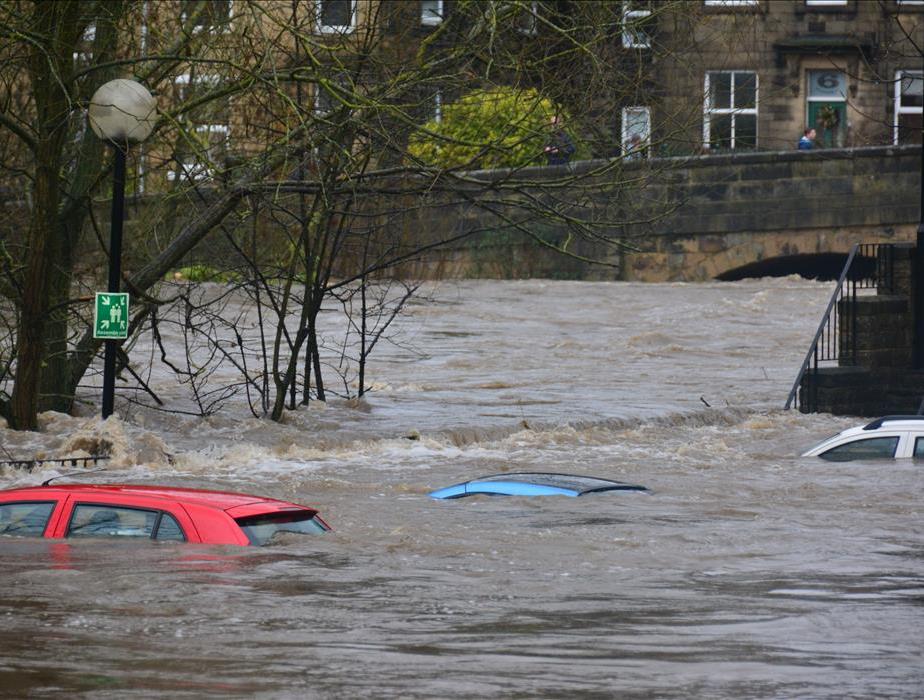 Cars are drawn from flood water
Cars are drawn from flood water
Entering flood waters, or staying after a flood has passed can bring about damage. Flooding is an impermanent flood of water onto land that is regularly dry. Floods are the most widely recognized catastrophic event in the United States. A result from rain, snow, coastal storms, storm surges, and overflows of water systems. Develop slowly or quickly – Flash floods can come with no warning. Cause outages, disrupt transportation, damage buildings, and create landslides.
How to Stay Safe During a Flood?
- Know types of flood risk in your area. Visit FEMA’s Flood Map Service Center for information.
- If flash flooding is a risk in your location, then monitor potential signs, such as heavy rain.
- Learn and practice evacuation routes, shelter plans, and flash flood response.
- Gather supplies in case you have to leave immediately, or if services are cut off. Keep in mind each person’s specific needs, including medication. Don’t forget the needs of pets. Obtain extra batteries and charging devices for phones and other critical equipment.
- Keep important documents in a waterproof container. Create password-protected digital copies.
- Protect your property. Move valuables to higher levels. Declutter drains and gutters. Install check valves. Consider a sump pump with a battery.
After returning home SAFE and the flood-affected your house, call SERVPRO of Downtown Long Beach / Signal Hill to assess the situation. We have the knowledge, tools, and storage so we can restore your house or business as fast as possible.
call us today at 562-420-0030
ARE YOU PREPARED FOR A STORM?
8/27/2019 (Permalink)
At SERVPRO of Downtown Long Beach / Signal Hill, we recognize that your home or business may not be adequately built to handle storm damage. If you experience damage caused by wind or water in the event of a storm, we’re here to help!
Torrents of black water, sewage water containing bacteria, mold, and viruses, begin to devastate businesses by first permeating through the floors, walls, and ceiling. Here the water can infiltrate through coating breaks, between seams, and under baseboards. When exposed to this kind of water, complete removal and replacement of contaminated areas is recommended. If the edges of your floorboards begin to rise, they can often be sanded by our SERVPRO technicians. Unfortunately, if the floorboards experience extreme saturation on the top layer of wood, sanding is not an option and complete removal might be the best course of action.
Strong winds can cause adjacent trees to become a hazard to your home or business. Did you know a single branch from a large tree could have enough weight to collapse a roof? As a result, runoff of torrential rains may begin to flow into your Long Beach home or business. In this situation, SERVPRO technicians can use penetrating moisture meters and special equipment to recommend the best course of action based on the amount of damage incurred.
If you find yourself in a situation too big to handle, call SERVPRO of Downtown Long Beach / Signal Hill for immediate and professional service at 562-591-1788.
PREPARING FOR HURRICANE SEASON BEFORE TRAVELING
7/26/2019 (Permalink)
Are you anticipating a storm or hurricane at your next travel destination?
While vacations are a time for relaxation, it might be concerning to discover a storm is headed for your tropical resort. Remain mindful of the following hurricane safety tips:
Before Traveling
Check the news: Stay up to date with the local weather at your vacation location up to a week in advance.
Obtain Hurricane Travel Insurance: Hurricane insurance can cover delays due to weather and help you cancel your trip or leave early.
Make paper copy of documents: Print and bring copies of your travel insurance, itinerary and key phone numbers, as well as your passport (if necessary) to make sure you have reliable back-ups in case internet is no longer available.
During a Hurricane
Identify a point of contact: It can be difficult to find cell service while on vacation so it is important to know where you can go to get in contact with friends or family members.
Identify Evacuation Routes: Once you reach your destination, it is important to identify proper evacuation routes and ask the hotel staff about their evacuation plan.
Be mindful of your surroundings: Avoid any electrical wiring if you are wet or if the wiring is wet.
SERVPRO of Downtown Long Beach/Signal Hill wishes you a safe and hurricane free vacation! If you're in need of any assistance related to storm damage, SERVPRO of Downtown Long Beach/Signal Hill is here to help. Call us at 562-591-1788
FLOOD DAMAGE CAN OCCUR ANYWHERE
7/23/2019 (Permalink)
Floods are a common and widespread natural disaster, often resulting from a storm or hurricane damaging your area. Regardless of where you’re located, floods can reach the mountains, the beach, or even the desert.
It is important to remain mindful of the following safety tips:
- Avoid floodwaters if possible. Even 6 inches of quickly moving water can sweep you off your feet. If you are caught in an area where water reaches above your ankles, find another path or walk another way.
- The same rules apply when driving. If you reach a flooded road, find a way around or follow the directions of safety personnel. Many vehicles can be carried away by as little as 2 feet of moving water! In extreme flooding, consider leaving your vehicle to find higher ground if rising waters do not subside.
- Be cautious of consuming or bathing in water found outside. Disease can be carried by contaminated floodwaters resulting in prolonged sickness.
Floods have the potential to cause extensive damage to property when not treated quickly, and cleanup can be an overwhelming task. SERVPRO of Downtown Long Beach / Signal Hill has the experience and knowledge to assist you when a flood strikes your home or business. We’re here 24/7 to help. Contact us at 562-591-1788
IMPORTANT STORM SAFETY TIPS
4/20/2019 (Permalink)
Where were you the last time you encountered a heavy storm? The key to storm and lightning safety is to avoid being in the wrong place at the wrong time. If you see a storm approaching on the horizon, remain indoors in case of a lightning strike. Lightning will follow the available paths to ground, including the electrical wiring, plumbing, or telephone lines. Try to avoid structures like bus shelters, outhouses, or any small non-metal structure that do not provide any lightning protection.
The fact that houses and buildings have an abundance of grounding paths makes them generally safe lightning shelters, but to ensure maximum safety during a storm:
- Don't use any wired appliance or device. Wireless appliances are safe to use.
- Stay away from water pipes and faucets. (No baths, showers, etc.)
- Don't stand on a basement floor or patio slab, or anywhere where standing water or excessive moisture is present. These areas are 'ground current' danger zones.
- Stay away from walls where electrical wiring is present.
If you find yourself on the road during a storm, you are safest in an enclosed, metal vehicle. The car should ideally have a hard top with its windows rolled up. If your car is struck by lightning, the current will flow through the metal body of the vehicle to the ground.
Keep the following safety tips in mind if you’re driving through a storm:
- If there is no shelter around and you must stay on the road, pull over, turn off your engine, and turn on your hazard lights while you wait out the storm.
- Do not touch anything metal inside of your car. This includes the radio, cell phone chargers, mobile GPS devices, door handles, and the steering wheel.
- If you’re on a motorcycle or a bicycle, do not seek shelter underneath trees. While trees may provide cover from the rain, this will greatly increase your risk of being struck by lightning.
If you experience property loss due to a storm, SERVPRO of Downtown Long Beach / Signal Hill is here to help with restoration and repair. We can clear debris, help reverse water damage, and get you back on your feet. Don’t be caught off guard; call us any day, morning or night.
REMAINING SAFE DURING FLOODS AND SEVERE WEATHER
4/2/2019 (Permalink)
Did you know a flood can occur in any one of the 50 United States? Even California is susceptible to flooding, in addition to harsh winds and mudslides. Therefore, it is important to be prepared for these emergency situations. Here we outline important ways to prepare for flooding and encourage you to think about your plan for harsh weather conditions.
According to the National Flood Insurance Program, follow these tips to stay safe during a flood:
- Seek higher grounds and avoid all areas that are at a higher risk of flooding
- If your home starts flooding, go to your top floor of your home, attic, or roof
- Don’t try walking across flooded streams or flooded roadways
- Turn off your main power and close your main gas valve
- Turn on and listen to a battery-powered radio for updated storm and flood information
- If you’ve touched floodwaters, wash your hands thoroughly with soap and water
- It’s important that you have an emergency supply kit in your home and vehicle in case of an emergency. You should also ensure you have you and your family’s medication pre-loaded with your emergency supply kit.
If your home is affected by flood water, keep the following tips in mind:
- Clear any debris from your gutters and/or downspouts
- Maintain your sump pump and install a battery backup in the case of a power outage
- Anchor fuel tanks
- Move valuables to a safe place
- Keep electrical components and appliances at least 12 inches above your house’s floor elevation
When driving through a storm, keep in mind most commuter vehicles were not designed to drive through flood water. Doing so can prevent airflow to your vehicle and lock up the engine, placing you in an even worse situation. Not only is it dangerous for you and your vehicle, but other people on the road as well.
Hopefully, with the helpful tips above, you can better prepare yourself and your home for severe weather. Even with proper planning, however, situations can go awry. SERVPRO of Downtown Long Beach / Signal Hill is here to help with damage caused by a storm or flooding. We're available day or night, 24/7.
HOW TO PROTECT YOUR HOME FROM SEVERE WINDS
2/25/2019 (Permalink)
Severe weather such as storms or hurricanes can bring strong winds traveling over 100 miles per hour. Even winds traveling 25 miles per hour have been shown to cause damage to homes and other property. Take note of the following points to learn about how you can prepare for the possibility of damaging winds.
- Secure outdoor furniture and decorations, or store in enclosed areas.
- Anchor and secure outdoor structures such as freestanding sheds or kennels to sturdy foundations.
- Inspect and repair loose roof shingles, especially if you own an older home or have older roofing materials. Wind damage begins small by prying up a corner, but each gust of wind comes closer to removing the entire shingle and increases risk to surrounding roofing materials. Additionally, anchor your home's siding firmly. As with the roof, wind can tear away large areas once a small piece has loosened.
- Remove overhanging branches by trimming and pruning your trees. This will help prevent unexpected debris from falling on your home and keep fire from spreading.
- Reinforce doors with deadbolts and don’t forget to fortify garage doors.
- Designate a safe area in your home or business to take shelter if necessary; a small, interior room with no windows is ideal.
- Store vehicles in a sheltered area and away from trees or objects that may become projectiles in a storm.
In addition to these tips, stay tuned to your local radio station, TV weather report, or internet news site for frequent weather updates. Should you experience damage from high winds or a storm, don't hesitate to call SERVPRO of Downtown Long Beach / Signal Hill for complete clean up, restoration, and repair.
NO STORM IS TOO LARGE
9/27/2018 (Permalink)
What happens if you find your Long Beach business or home in the middle of a storm? At SERVPRO of Downtown Long Beach / Signal Hill, we recognize that buildings are not always adequately constructed to handle changing weather conditions. We are here to help with damage caused by wind or water in the event of a storm.
In September of 2015, the remnants of Hurricane Linda brought localized downpours from Santa Barbara to San Diego, California. That month, Los Angeles received 2.39 inches of rain, making it one of the wettest September days since 1877. Many older homes and businesses in L.A. County found themselves overwhelmed and unprepared.
In a storm such as this, torrents of black water, sewage water containing bacteria, mold, and viruses, begin to devastate businesses by first permeating through the floors, walls, and ceiling. Here the water can infiltrate through coating breaks, between seams, and under baseboards. If combined with dirt, mold may even begin to develop. When exposed to this kind of water, complete removal and replacement of contaminated areas is recommended. If restoration is an option, it is important to note how the wooden floor boards begin to expand and warp. Cupping occurs when the edges of floorboards begin to rise and can be sanded down by our SERVPRO technicians. Unfortunately, if the floor boards begin to crown due to an oversaturation of the top layer of wood, sanding is not an option and complete removal might be the best course of action.
Strong winds can cause adjacent trees to become a hazard to your home. A single branch from a large tree could have enough weight to collapse a roof or create an opening in the side of your house. As a result, runoff of torrential rains may begin to flow into your Long Beach home. In this situation, SERVPRO technicians can use penetrating moisture meters and special equipment to recommend the best course of action based on the amount of damage incurred.
Across the nation, SERVPRO has you covered with the Commercial Large Loss Division and the Disaster Recovery Team. With the ability to mobilize local command centers, along with the resources of more than 1,700 franchises nationwide, no disaster is too big. Every large loss is supervised by a commercial operations manager to help ensure seamless communication and timely mitigation. If you find yourself in a situation too big to handle, call SERVPRO of Downtown Long Beach / Signal Hill for immediate and professional service.
STORM - HURRICANE HARVEY 2017
7/25/2018 (Permalink)
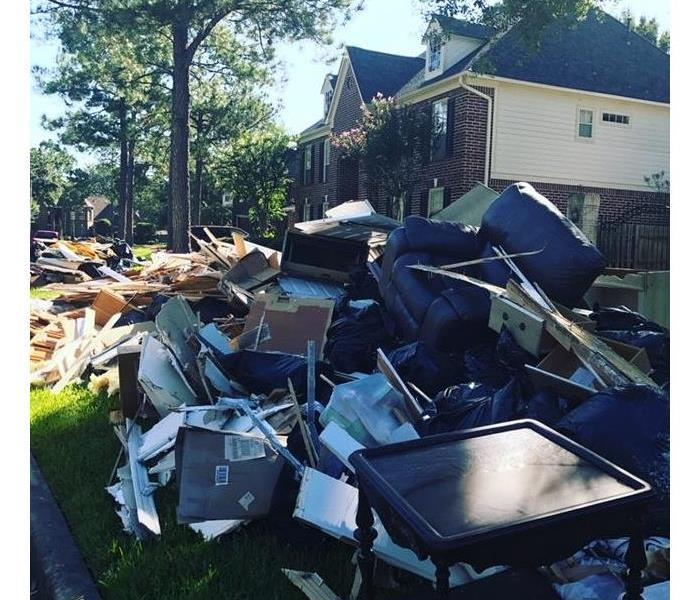 A home in Houston ravaged by Hurricane Harvey
A home in Houston ravaged by Hurricane Harvey
It has been nearly a year since SERVPRO of Downtown Long Beach/Signal Hill packed up three trucks to make the drive from Long Beach, California to Houston, Texas to help with water damage repair cleanup from Hurricane Harvey. So, what was it like?
The drive took three full days due to the heavy equipment we carried with us. As we came closer to Houston, we had trouble fueling up our diesel truck. Driving from small town gas station to small town gas station along our route, we were met with signs over the gas nozzles announcing “Out of Fuel.” The lines were very long, with tempers flaring as locals and long-distance truck drivers competed to fill up their vehicles.
On Day 3 we made it to Houston in the afternoon. The traffic was terrible – and this is someone from Los Angeles saying this. There were many main roads that were still underwater, some looking like rivers as we passed them. We were fortunate to have a friend with a small apartment in Southeast Houston that we could stay at. It became our office, kitchen, and sleeping quarters. A hotel was rented for our technicians who flew in to help with the cleanup work.
The first couple days in Houston was spent organizing supplies, getting the layout of the city, and generally preparing to get started on the work. SERVPRO Storm Team started to send us a steady flow of work after about 4 days. Now, when you are responding to storm damaged homes, there is only so much preparation you can do beforehand. The real problem solving happens in the field once you have your boots on the ground.
The first impression I had when we started working was the great resourcefulness of Texans. Friends and neighbors came to each other’s aid to help pull out damaged furniture, remove drywall, and provide moral support and humor. Driving down neighborhoods, we saw piles of drywall, clothing, and furniture piled high in front yards. After a few days of trash not being cleared, the smell started to fill the humid air. The odor was like what you experience when you clean out a dirty fish tank. Many cars were unusable due to being flooded, so they sat with steamy windows until the towing companies could come through to take them to the junk yards. Despite all this, restaurants were open, Home Depot and Loews were open for business, and people went about their days as best they could, patching the city back together.
The worst houses we worked on were the ones that had been completely swept through with mud. Imagine a tidal wave of mud floating through the entire downstairs of your home. The water lines were taller than me on some of the homes. The mud was everywhere – caked on the floors, on the wall studs behind the drywall, on furniture and clothing. We would remove the furniture, the affected drywall, complete a pressure washing of all the surfaces while extracting the runoff, and then finish by hand wiping, vacuuming, and mopping all the affected areas at least one or more times. The final treatment would be an antimicrobial application.
The customers with the most badly affected homes were the nicest and most grateful. When they could have been angry at their circumstances, they instead showed gratitude. Our crews put in long days with a smile fueled by the good attitudes of our customers. Even the massive number of mosquitoes from all the standing water couldn’t keep us down.
After a month in Houston, we made the long ride back to Los Angeles. The home office ran smoothly in our absence, thanks to our wonderful General Manager and the crews that stayed behind. It was a great adventure. We hoped to have some much-needed downtime when we got back, but Mother Nature had other plans. We returned home to blazing wildfires in Los Angeles and Orange County. Off to help with the fire damage cleanup we went because at SERVPRO of Downtown Long Beach/Signal Hill and SERVPRO NE Long Beach/Lakewood we are here to help with fire damage repair and water damage repair both on the road and in our own backyard.
TSUNAMI: A VERY REAL THREAT IN CALIFORNIA
7/13/2018 (Permalink)
 Being on the coast, Tsunami preparedness is critical for Long Beach
Being on the coast, Tsunami preparedness is critical for Long Beach
Living in California, and especially along the coast, we’re aware that we can feel the negative impacts from natural threats such as tropical storms and Tsunamis. In fact, just off the coast of California lies the Cascadia fault – which is thought to be up to 30 times more powerful than its more famous neighbor, the San Andreas fault.
SERVPRO of Downtown Long Beach/Signal Hill is here to assist when your home or business is affected by water, fire and storm damages. We also want to provide you information to help you avoid loss or damage to property, personal belongings or, in the worst case, people. Here are some insights about Tsunamis to keep you informed:
Ready.gov classifies a tsunami as "a series of enormous waves created by an underwater disturbance such as an earthquake, landslide, volcanic eruption, or meteorite." Tsunamis are also known as seismic sea waves and often mistaken for tidal waves. Areas within a mile of the coast and less than 25 feet about sea level have a greater risk of being hit, according to www.Ready.gov
It is important to be aware of evacuation routes close to the beach and have an emergency plan prepared in case one strikes. It is also very important to understand that the first wave often is not the last and could get larger. Once you have reached higher ground, make sure to stay away from effected sites until officials deem them safe. Flooding is the most common safety hazard but, in the aftermath of the event, landslides, floods, debris, and/or contaminated drinking water can also occur.
If you are traveling anywhere tropical, you may want to check out www.tsunami.gov in advance to determine if there are advisory warnings, threats, etc. Also, make sure you keep up-to-date on where to go during an emergency evacuation due to tsunami and who to contact once you reach a safe area.
If your property becomes damaged from a tsunami, or from any loss caused by water, fire, storm or biohazard, SERVPRO of Downtown Long Beach/Signal Hill is here to clean up, restore and, when needed, reconstruct your home or business. Reach us 24/7 at 562-562-1788
STORM DAMAGE: HOW TO BE PREPARED
7/8/2018 (Permalink)
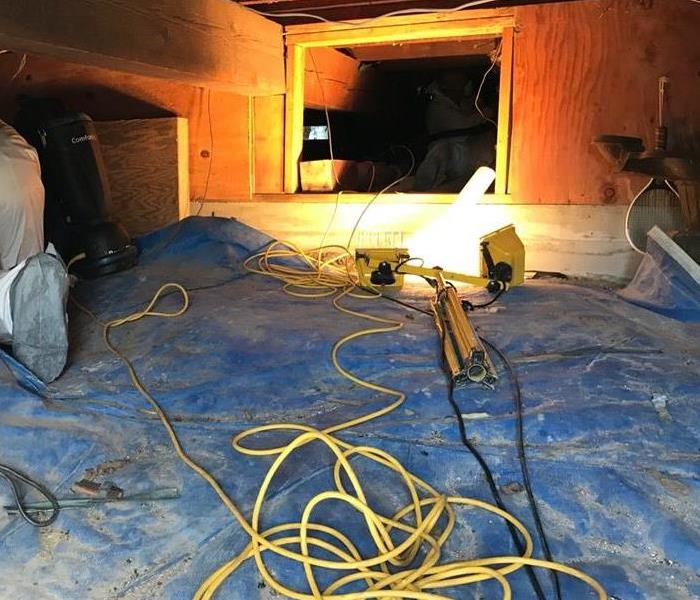 Storm Damage to a Home in Santa Barbara
Storm Damage to a Home in Santa Barbara
The devastation caused by storm damage can be far-reaching. The residents and business owners in the Greater Santa Barbara area were victims to the cruel effects of the wild fires, mud slides and extreme water damage occurring this year. SERVPRO of Downtown Long Beach/Signal Hill was there to help with cleanup, restoration and reconstruction expertise.
When a wild fire has affected an area, it becomes susceptible to landslides due to destabilization of the soil or foundation. When a storm is threatening, preplanning and preparation can assist in lessening storm and water damage.
The most important thing to know is how to recognize when the storm will be approaching and the signs that come along with a landslide. Change in the landscape and sudden cracks in the pavement are major signs that a landslide may occur at your home. Indicators such as pipes bursting, and crackling of trees or light rumbling sounds are signs that the ground beneath is moving.
During a severe storm make sure to stay alert and awake. Move away from the path of a landslide or debris flow as quickly as possible. The danger from a mudflow increases near stream channels and with prolonged heavy rains. Make sure to stay clear of all rivers or open bodies of water. If escape from the landslide is not possible, authorities recommend you curl into a tight ball and cover your neck and head as much as possible.
After a landslide make sure you stay away from affected until advised otherwise. Look for and report broken utility lines and damaged roadways and railways to appropriate authorities. Reporting potential hazards will get the utilities turned off as quickly as possible, preventing further home emergencies. SERVPRO of Downtown Long Beach/Signal Hill is here to assist you with any storm damages, as well water and fire damages, affecting your home or business. Call us, 24/7, when emergency strikes: 562-591-1788
STORM/HURRICANE SEASON WHERE YOU'RE GOING? BE PREPARED!
7/2/2018 (Permalink)
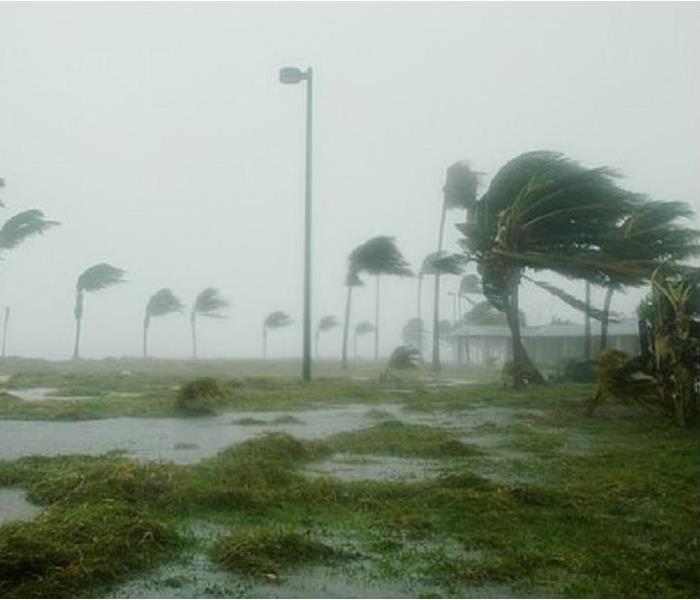 Hurricane Season
Hurricane Season
Headed for a vacation destination that’s prone to Storms and Hurricanes?!
Vacations are a time for relaxation but what if an emergency strikes? It’s hurricane season and here at SERVPRO of Downtown Long Beach/Signal Hill we are always looking out for our customers safety and well-being. We've put together some tips for what to do if a hurricane strikes on your vacation and how to prep before you leave.
Before the trip:
While this might seem like an obvious tip it is very important to be up to date with the local weather at your vacation location. We recommend checking a week in advance to keep yourself up to date so there are no weather surprises while away!
- Get Hurricane Travel Insurance
When it comes to traveling, travel insurance is very important but specifically hurricane travel insurance during hurricane season is helpful. They’ll cover delays due to weather, accommodation cancelations, and going home early coverage, etc.
- Make paper copy of documents
It is always important to make copies of your documents before you travel just incase something happens to them, where it be theft or a storm damages them! Print and bring copies of your travel insurance, itinerary and key phone numbers as well as your passport (if necessary).
During hurricane:
- Identify a point of contact
It can be difficult to find cell service while on vacation so it is important to know where you can go to get in contact with others.
- Identify Evacuation Routes
Once onsite at your vacation, it is important to identify what the proper evacuation routes are to get to safety. Ask your hotel, landlord, or locals what those might be.
- Avoid any electrical wiring if you are wet or if the wiring is wet.
This will keep you from being electrocuted by any faulty wiring.
SERVPRO of Downtown Long Beach/Signal Hill wishes you a safe and hurricane free vacation! We hope these tips have provided you the proper information to being ready and handling a hurricane emergency while on vacation. If you're in need of any assistance SERVPRO of Downtown Long Beach/Signal Hill is here to help. Call us at 562-591-1788
FLOOD DAMAGE - IT CAN OCCUR ANYWHERE!
2/27/2018 (Permalink)
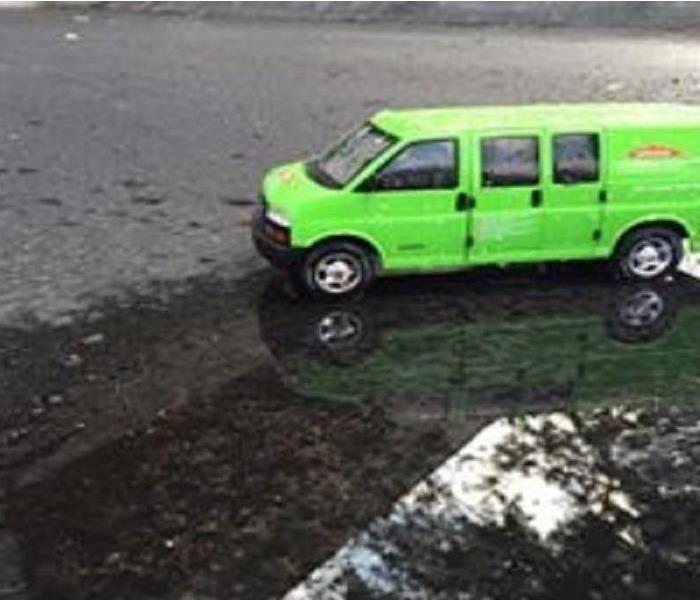 When heavy rains cause flooded streets...hazardous conditions may come next! Use Caution!!
When heavy rains cause flooded streets...hazardous conditions may come next! Use Caution!!
Throughout the US, floods remain one of the most widespread and common natural disasters that affect us. No matter where you’re located, in the mountains, along the coast, in the city, close to a river or out in the desert, you can still be impacted by a flood.
Here are some important safety tips to keep in mind:
- Even 6 inches of quickly moving water can sweep you off your feet so steer clear of floodwaters. If you find yourself in an area where water reaches above your ankles, find another path, walk another way.
- When driving, the same rules apply: If you approach a flooded road, turn around and go another way. Most vehicles can be carried away by less than 2 feet of moving water. If caught by rising waters and the situation warrants it, get out of your car quickly and move to higher ground.
- Protect children from the dangers and disease carried by contaminated floodwaters. What might look like a fun activity to them could prove deadly.
SERVPRO of Downtown Long Beach / Signal Hill has the experience and knowledge to assist you when a flood strikes your home or business. No matter the size, floods have the potential to cause extensive damage to property when not treated quickly and properly and the cleanup can be an overwhelming task.
We’re here 24/7 to help. Contact us at 562-591-1788






 24/7 Emergency Service
24/7 Emergency Service
